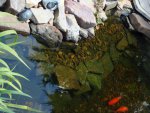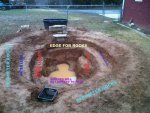I know this is more of an encouragement forum than one for critiques, but for what it's worth...
pondlover, that's a lot of complex shelves and they seem tight. By tight I mean tight edges, narrow ledges, lots of curves. Kind of like you wanted it to look "interesting". That would be find for fiberglass, but I would expect problems with liner over soil. For sure you want a thin underlayment. Carpet padding for example wouldn't work. However, I wouldn't expect any underlayment to stay in place very well.
The first problem will be getting the liner in place. I've lost track of the liner to be used, but something heavy like 45 mil EPDM is not going to like comforming to those angles and edges, fig A.
At the very least I think you'd have to place heavy concrete blocks on the ledges as you try and lay the liner, fig B. Repositioning a liner is really hard. Repositioning a liner with blocks on it is impossible. You really have to fold up the liner just so, and position it almost exactly at the bottom of the pond and then unfold it as you go. If this sounds hard, it is. This is a small enough pond that maybe it can be manhandled into place.
Also notice in fig B when the blocks are placed the top of the liner comes down, and the liner may become short on one side. Even if blocks aren't used this effect will occur when filled with water. This is why it's suggested to buy a bigger liner and not cut until there's water in the pond. But in your case it's even more important. All those steps will pull down the liner more than most ponds. Also it's a bit difficult to predict how much liner on which side will be pulled down the most.

Fig C shows that sharp soil edges often do not stay perfectly in place. For a single wide shelf the erosion isn't too big a deal in many cases at least for the first few years. Losing 1" off an 18" wide shelf isn't as noticeable as 1" off a 6" shelf. When soil erodes it falls down filling in the 90 degree corner.
The erodsion can happen when the liner is being installed as well as later.
Now for the hard part...You also have to pleat the rectanglar liner so it fits into a round hole. In a rectanglar pond this is called "folds". Your pond shape means some pretty serious pleating. Those folds will add more issues to laying the liner on those shelves.
In the end I don't think you will have any, or many, useful shelves. They will be more like bumps. I'm just guessing, hard to tell from pictures. The bigger the pond the better the liner lays, fewer folds, etc.
I'm a big believer in people having the ponds they want and always encourage pushing the envelope. This is more of a heads up in case the liner install gets to be a nightmare. At least you won't think you're doing something wrong and you can consider a plan B at that point if needed. On the upside there's little risk to trying.
pondlover, that's a lot of complex shelves and they seem tight. By tight I mean tight edges, narrow ledges, lots of curves. Kind of like you wanted it to look "interesting". That would be find for fiberglass, but I would expect problems with liner over soil. For sure you want a thin underlayment. Carpet padding for example wouldn't work. However, I wouldn't expect any underlayment to stay in place very well.
The first problem will be getting the liner in place. I've lost track of the liner to be used, but something heavy like 45 mil EPDM is not going to like comforming to those angles and edges, fig A.
At the very least I think you'd have to place heavy concrete blocks on the ledges as you try and lay the liner, fig B. Repositioning a liner is really hard. Repositioning a liner with blocks on it is impossible. You really have to fold up the liner just so, and position it almost exactly at the bottom of the pond and then unfold it as you go. If this sounds hard, it is. This is a small enough pond that maybe it can be manhandled into place.
Also notice in fig B when the blocks are placed the top of the liner comes down, and the liner may become short on one side. Even if blocks aren't used this effect will occur when filled with water. This is why it's suggested to buy a bigger liner and not cut until there's water in the pond. But in your case it's even more important. All those steps will pull down the liner more than most ponds. Also it's a bit difficult to predict how much liner on which side will be pulled down the most.

Fig C shows that sharp soil edges often do not stay perfectly in place. For a single wide shelf the erosion isn't too big a deal in many cases at least for the first few years. Losing 1" off an 18" wide shelf isn't as noticeable as 1" off a 6" shelf. When soil erodes it falls down filling in the 90 degree corner.
The erodsion can happen when the liner is being installed as well as later.
Now for the hard part...You also have to pleat the rectanglar liner so it fits into a round hole. In a rectanglar pond this is called "folds". Your pond shape means some pretty serious pleating. Those folds will add more issues to laying the liner on those shelves.
In the end I don't think you will have any, or many, useful shelves. They will be more like bumps. I'm just guessing, hard to tell from pictures. The bigger the pond the better the liner lays, fewer folds, etc.
I'm a big believer in people having the ponds they want and always encourage pushing the envelope. This is more of a heads up in case the liner install gets to be a nightmare. At least you won't think you're doing something wrong and you can consider a plan B at that point if needed. On the upside there's little risk to trying.



